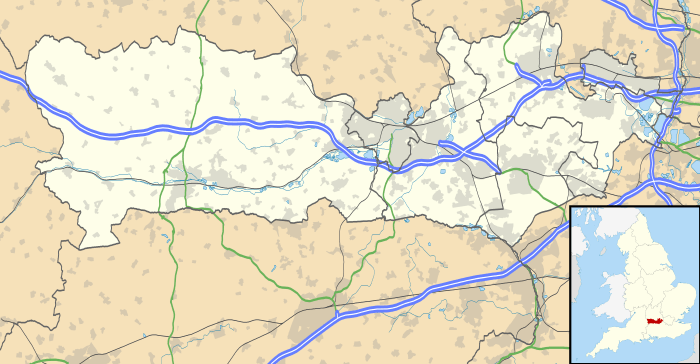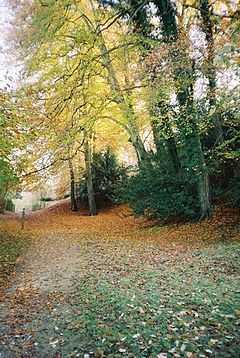Bisham Woods
Coordinates: 51°33′27″N 0°46′00″W / 51.5574°N 0.7666°W
| Bisham Woods | |
|---|---|
|
Fultness Wood, part of the ancient beechwood at Bisham Woods | |
 Bisham Woods | |
| OS grid reference | SU856850 |
Bisham Woods are a series of woods between Bisham Abbey and Cookham Dean in Berkshire. They include an 83.7 hectare biological Site of Special Scientific Interest, notified in 1970,[1] with a claim to be "the richest ancient woods in Berkshire".[2] It is also a Local Nature Reserve.[3][4]
The woods have been owned and managed by the Woodland Trust since 1990,[5] and consists of several sections, covering a total of 153.2ha (378.57 acres). The northern part is the ancient woodland SSSI, with compartments known as Quarry Wood, Fultness Wood, High Wood and Inkydown Wood. With the River Thames just to the north, and views across the Chiltern Hills, they include beechwoods, with rare woodland orchids.[6] The remaining compartments, including Park Wood, High Wood, and Goulding's Wood, Carpenters Wood and Dungrovehill Wood are areas of 19th and 20th century planting noted for bluebells. These are nearer Maidenhead, near the A308 and A404. The woods are open to the public, and are well served with paths and bridleways, with parking nearby.[7]
Quarry Wood is the site of Bisham Quarry, an important medieval source of stone, much of which was used to build Windsor Castle. From medieval times the woods were part of the extensive Bisham Estates of the Earls of Salisbury.[8] An ice house, built in the 1760s to provide ice for Bisham Abbey is within the woods, and opened to the public four times a year.[9] The Woods are said to have been the original 'Wild Wood' in Kenneth Grahame's Wind in the Willows, which he wrote in the nearby village of Cookham Dean.[2] Percy Bysshe Shelley composed The Revolt of Islam in the area of Bisham Woods in 1817 when he was living at Marlow.[10]
A memorial in Carpenters Wood commemorates the crash site of a Halifax Bomber from the Royal Air Force 578 Squadron, on 18 July 1944. The memorial was dedicated on 18 July 1998.[11]
See also
- List of Ancient Woods in England
- List of Sites of Special Scientific Interest in Berkshire
References
- ↑ English Nature citation sheet for the site (accessed 27 December 2007)
- ↑ 2.0 2.1 Jo Tweedy, This is Travel, Daily Mail, 29 October 2003 Accessed 16 Oct 2011
- ↑ "Bisham Woods". Local Nature Reserves. Natural England.
- ↑ "Map of Bisham Woods". Local Nature Reserves. Natural England.
- ↑ 'Welcome to Bisham Woods.' Information board within the woods,
- ↑ Wild About Britain
- ↑ Woodland Trust, 'About this wood'
- ↑ David Nash Ford's Royal Berkshire History - Bisham accessed 16 Oct 2011
- ↑ Woodland Trust Management Plan 2009-2014
- ↑ The Literature Network The Revolt of Islam
- ↑ RAF Commands Forum
External links
- English Nature website (SSSI information)
- Bisham Woods on the VisitWoods website
- Woodland Trust Management Plan 2009-2014
